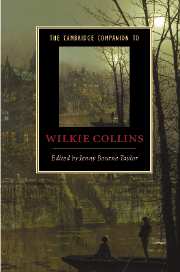Book contents
- Frontmatter
- Introduction
- 1 Collins’s career and the visual arts
- 2 The early writing
- 3 Collins’s shorter fiction
- 4 Collins and the sensation novel
- 5 The Moonstone, detective fiction and forensic science
- 6 The later novels
- 7 The professional writer and the literary marketplace
- 8 The marriage plot and its alternatives
- 9 Collins and Victorian masculinity
- 10 Collins and empire
- 11 Disability and difference
- 12 Collins and the theatre
- 13 The afterlife of Wilkie Collins
- Further reading
- Index
- Series List
13 - The afterlife of Wilkie Collins
Published online by Cambridge University Press: 28 January 2007
- Frontmatter
- Introduction
- 1 Collins’s career and the visual arts
- 2 The early writing
- 3 Collins’s shorter fiction
- 4 Collins and the sensation novel
- 5 The Moonstone, detective fiction and forensic science
- 6 The later novels
- 7 The professional writer and the literary marketplace
- 8 The marriage plot and its alternatives
- 9 Collins and Victorian masculinity
- 10 Collins and empire
- 11 Disability and difference
- 12 Collins and the theatre
- 13 The afterlife of Wilkie Collins
- Further reading
- Index
- Series List
Summary
Andrew Lloyd Webber's musical spectacular The Woman in White opened in London in September 2004. Posters featuring a back-lit, white-clad woman had appeared on buses and Tube trains for months before, and the casting of Michael Crawford (the most famous star in Lloyd Webber's The Phantom of the Opera) as the first Count Fosco seemed to lodge Collins's novel firmly in Lloyd Webber world. The official publicity paid its dues to Collins but acknowledged that the story had been appropriated to a familiar repertoire - 'a love story to which a layer of unrequited love [Marian for Walter] has been added for the musical' - and the evening clearly offers a branded 'Lloyd Webber' experience, complete with souvenir tapestry kits and pill-boxes. Nonetheless, the modern musical Woman in White was strongly shaped by the contexts and forms of Collins's writing, sensation fiction and the mid-Victorian practices of writing and publishing popular fiction. Far from being a travesty of the 'original' novel or a postmodern rerendering of Victorian Gothic, this new musical version can be viewed as a natural offspring of Collins's novel and its first set of contexts. My emphasis in this chapter will be on the continuities between Collins's novels in their first intertextual setting and in their many and varied versions in film, radio and television, with a focus on the British Broadcasting Corporation, and in novels. In addition to the publishing history of the texts themselves, the history of Wilkie Collins in the twentieth century encompasses some of the earliest silent films, the changing traditions and conventions of British radio and television drama, and the historical fiction of Sarah Waters, James Wilson and other 'contemporary Victorian' writers. It forms a crucial part of the continuities and shifts in the significance of the 'Victorian' across the twentieth century and into the twenty-first.
- Type
- Chapter
- Information
- The Cambridge Companion to Wilkie Collins , pp. 181 - 193Publisher: Cambridge University PressPrint publication year: 2006



